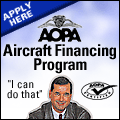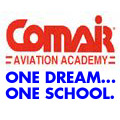Departments

Inside AOPA 
On Capitol Hill 
Airport Support Network

Quiz Me! 
ePilot Calendar 
Weekend Weather
| GA News
| CIRRUS CERTIFIES SR22
 Cirrus Design Corporation received FAA approval for its new Cirrus SR22 aircraft last Thursday. The certification of Cirrus Design's newest model comes just 14 months after engineering development began and only nine months after the company submitted its application to the FAA. The SR22, with a 310-hp Teledyne Continental IO-550-N engine, cruises at 180 knots at 75 percent power, climbs at 1,400 feet per minute at sea level, has a range of more than 1,000 nautical miles, and a useful load of 1,150 pounds. The first customer SR22 is expected to come off the line by the end of the year. The base price is $276,600, including a leather interior and three-blade propeller. For more, see the Web site. Cirrus Design Corporation received FAA approval for its new Cirrus SR22 aircraft last Thursday. The certification of Cirrus Design's newest model comes just 14 months after engineering development began and only nine months after the company submitted its application to the FAA. The SR22, with a 310-hp Teledyne Continental IO-550-N engine, cruises at 180 knots at 75 percent power, climbs at 1,400 feet per minute at sea level, has a range of more than 1,000 nautical miles, and a useful load of 1,150 pounds. The first customer SR22 is expected to come off the line by the end of the year. The base price is $276,600, including a leather interior and three-blade propeller. For more, see the Web site.
SJ30-2 PROTOTYPE TAKES FLIGHT
The first conforming prototype of the Sino Swearingen SJ30-2 business jet made its maiden flight last Thursday. The seven-place jet flew for 45 minutes before returning for landing at San Antonio International Airport. The first flight marks the beginning of the SJ30-2's flight test program for FAA certification. Company officials expect the process to take one year where 1,400 flight hours will be logged on three airframes. "This is history in the making," said Sino Swearingen President and CEO Jack Braly. "The SJ30-2 will be the first business jet to be certified under FAR 23 commuter category regulations, and it will be the first business jet to be certified by a new aircraft company in almost 40 years." For more, see the Web site.
COMMANDER AIRCRAFT PRESIDENT DIES
Dean Thomas, president of Commander Aircraft in Bethany, Oklahoma, died unexpectedly Sunday evening, December 3. Company officials said Thomas, 46, died in his sleep of natural causes. Additional details were not available at ePilot deadlines. Thomas was formerly a vice president at Piper Aircraft in the late 1980s and early 1990s.
OFFICIALS QUESTION STATEMENT ON STEWART CRASH
Aviation industry officials are challenging a statement that came out of the investigation into the death of golfer Payne Stewart. The 13-month NTSB investigation showed that the Learjet 35 crash, which killed six people, was a result of cabin depressurization and the failure of the crew to obtain supplemental oxygen. Last week NTSB Chairman Jim Hall said that with the rapid growth in fractional and charter operations, business jets should be treated the same as commercial airliners when it comes to safety. The National Air Transportation Association (NATA) found Hall's statement troubling. Citing the NTSB's own statistics, NATA said that there have only been five fatal accidents involving Part 135 jets between January 1987 and October 2000. That compares to more than 20 fatal accidents involving Part 121 airline jets over the same period.
WHAT DOES STEWART CRASH MEAN FOR REGS?
Questions remain about what regulatory changes might come out of the Payne Stewart crash. The NTSB recently issued 11 safety recommendations to the FAA, mostly centering on crew training and ways to improve pressurization systems. Earlier this year, the FAA took action on what AOPA calls a "knee-jerk" airworthiness directive. AOPA opposed the AD requiring a change to flight manuals on Learjet Models 35, 35A, 36, and 36A. "That was clearly a flight crew training (operational) issue and not an airworthiness concern issue," said Lance Nuckolls, AOPA director of regulatory and certification policy. "AOPA also believes that this proposed AD was precipitated by the FAA's compulsion to initiate some regulatory action in response to the Payne Stewart tragedy." For more, see AOPA Online.
ECLIPSE SECURES MORE FUNDING
Eclipse Aviation Corporation has secured $125 million for advancement of its light jet design. The second round of equity investment, totaling $65 million, came from new and existing private investors. "The investment community's continued support demonstrates their recognition that we have both validated the market and made significant development progress," said Vern Raburn, president and CEO of Eclipse. "We are well positioned to deliver the Eclipse 500 on schedule, on budget, and at the price and performance we guaranteed, despite claims to the contrary from industry skeptics." For more, see the Eclipse Web site.
GARMIN GOES PUBLIC
Garmin International Inc., known for its GPS technology, filed paperwork with the Securities and Exchange Commission to sell its stock to the public on the NASDAQ exchange. The company will offer today 10.5 million shares at a price of $15 to $17 under the symbol GRMN. For more on Garmin, see the Web site.
For daily news updates, see AOPA Online.
|
Inside AOPA
| AOPA OPPOSES POSSIBLE CESSNA 172RG AD
AOPA is expressing opposition to a proposed airworthiness directive that could affect 766 retractable-gear Cessna 172s. The FAA cited numerous reports of the main landing gear pivot assemblies failing, resulting in gear-up landings or loss of braking. The FAA estimated the cost of compliance could range from $1,700 to $7,600. Based on extensive research, AOPA believes that the FAA's findings warrant an airworthiness concern, but it is best remedied through the issuance of a general aviation alert or special airworthiness information bulletin (SAIB), not an AD. For more, see AOPA Online.
BOYER COMPLETES PTM TOUR FOR THE YEAR
AOPA President Phil Boyer hosted the 234th Pilot Town Meeting in Phoenix last Tuesday. Since Boyer first started going out on the road eight years ago to talk directly to the nation's aviators, more than 45,500 have participated in these sessions. "Pilot Town Meetings are a learning vehicle for me and AOPA," Boyer said. "We started this program to become more familiar with the concerns of pilots and owners through a direct, personal exchange of views. I credit this continual feedback, in addition to continual member research, with helping guide AOPA in constantly improving its service to members."
AOPA PUSHES FOR RNAV CHARTING
AOPA has officially requested that the FAA establish the capability to create and chart area navigation (RNAV) airways by March 2003. At least three applications that require the establishment of RNAV airways were identified at recent government meetings, including IFR routes through terminal areas, RNAV airway overlays which have lower minimum en route altitudes (MEA's), and RNAV airways that enable continued use of existing airways where a navaid signal is no longer suitable for en route navigation. AOPA requested that these airways (flyable with GPS or FMS) be established in preparation for the transition to RNAV. Increased airspace access (RNAV airways and precision approaches) and reducing the cost of flying (a low-cost database and direct routing without delays) are key ingredients identified by AOPA members as incentives for the RNAV transition.
AOPA POSTS GA COMMERCIALS ONLINE
AOPA's 13-day national TV advertising blitz promoting the value of community airports can be viewed online by AOPA members. The 30-second spots will run from December 22 through January 3 on The Weather Channel. To view the commercials, follow the link to AOPA Online.
| On Capitol Hill
| CLINTON ORDERS AIR TRAFFIC PBO
President Clinton on Thursday signed an executive order creating the "Air Traffic Organization," a so-called performance-based organization inside the FAA that will run the air traffic control system. The president also called on Congress to finance ATC with "cost-based charges on commercial users of the air traffic system," replacing existing excise taxes with user fees. "AOPA remains strongly opposed to user fees for any sector of the aviation community," said AOPA President Phil Boyer. "There is no financial crisis. Thanks to AIR-21, Congress has provided the FAA sufficient funds to modernize the air traffic control system." Boyer noted that Congress must approve any changes to air traffic control funding. Congress has rejected user fee proposals for the last seven years. "The administration, in its twelfth hour, is trying yet again to resurrect pieces of its USATS (U.S. Air Traffic Services Corporation) proposal," said Boyer. "User fees won't reduce airline delays, but they will increase ticket costs for many airline passengers, particularly those flying on 'low-cost' carriers. Aviation excise taxes remain the most efficient way to generate sufficient funds for FAA operations."
CONGRESS CONVENES FOR 'LAME DUCK' SESSION
The House and Senate convened this week for a "lame duck" session in order to place the finishing touches on four spending bills for fiscal year 2001. Spending bills to fund the FAA were passed earlier this year in accordance with the historic provisions of AIR-21. None of the outstanding bills will affect funding for the nation's airport and airway system. Congress and the White House were unable to agree upon terms for the remaining bills prior to the November 7 election, forcing them to return for final negotiations. The two sides will pass continuing resolutions that will keep the government open until final agreement can be reached. Senate leaders were hopeful that the final legislative business of the 106th Congress could be finished by the end of the week.
| Airport Support Network
| VOLUNTEER OF THE WEEK–ROBERT EVANS
Airport Support Network volunteer Robert Evans, from Tri-Cities Regional, Bristol/Johnson/Kingsport (TRI), Tennessee, has been working with federal, state, and local officials to enlist support for an overall upgrade of airport facilities. A luncheon rally using the AOPA video and support information is in the planning stages.
Click here to learn more about the Airport Support Network.
| Quiz Me!
| Here’s a question asked by an AOPA member last week of our AOPA technical specialists. Test your knowledge.
Question: Would you give me some history on the origin of the E-6B flight computer?
Answer: Although there have been a number of mechanical computers, the E-6B that we are familiar with is attributed to Philip Dalton, a reservist in the U.S. Navy. In 1933, he introduced a time-speed-distance computer, based on the circular slide rule. Later he added a component that provided calculations for a wide range of airspeeds. This final model was dubbed by the U.S. Army Air Corps as the Dalton dead reckoning E-6B. For the full history of the E-6B, see the Web site for Barry Schiff’s article that ran in the April 2000 issue of AOPA Pilot.
Got a technical question for AOPA specialists? Call 800/872-2672 or e-mail to [email protected]. Send comments on our Quiz Me! questions to [email protected].
| What's New At AOPA Online
| AOPA members can now post comments in the online Airport Directory about their experiences at airports or FBOs. On each airport detail page, you’ll see a new "Member Comments" link just below the "Kneeboard Format" link. Check it out on AOPA Online.
| ePilot Calendar
| WEEKEND FLYING DESTINATIONS
In response to member requests, some destinations will be posted one week in advance.
Kill Devil Hills, North Carolina. The anniversary of the Wright Brothers’ first successful flight is celebrated December 17. First Flight Airport (FFA), 252/473-2111, is the host airport. Call 252/441-1903 for event information.
Dallas, Texas. The Frontiers of Flight Museum hosts North Texas Aviation’s "Contributions to Winning WWII" December 15. Dallas Love Field (DAL), 214/670-6073, is the host airport. Call 214/350-3600 for event information.
Richmond, Virginia. A First Flight Celebration takes place at Richmond International Airport (RIC), 804/226-3000 December 16. Call 804/236-3622 for event information.
West Palm Beach, Florida. A pancake breakfast and Young Eagles rally takes place December 16 at Palm Beach County Park (LNA), 561/965-6400. Call 561/747-9100 for event information.
For more airport details, see AOPA’s Airport Directory Online. For more events, see the Aviation Calendar of Events.
ASF FLIGHT INSTRUCTOR REFRESHER CLINICS
(All clinics start at 7:30 a.m.)
The next AOPA Air Safety Foundation Flight Instructor Refresher Clinics are scheduled in Reston, Virginia, Lincoln, Nebraska, and Orlando, Florida, December 16 and 17. For complete details, visit the Flight Instructor Refresher Clinic schedule.
ASF SAFETY SEMINARS
The next AOPA ASF Safety Seminars are scheduled in St. Louis, Missouri, January 8; Springfield, Missouri, January 9; Kansas City, Missouri, January 10; and Wichita, January 11. For more information see Web site.
ASF PINCH HITTER GROUND-SCHOOL COURSES
(Pinch Hitter courses start at 9:30 a.m.)
The next Pinch-Hitter� Ground School will take place December 17 in Orlando, Florida. For details and a complete schedule, see the Pinch Hitter Ground School Schedule.
AOPA PILOT TOWN MEETINGS
Featuring AOPA President Phil Boyer
(7:30 p.m.; admission is free)
The next Pilot Town Meetings are in Tallahassee, Florida, January 30; Fort Lauderdale, Florida, January 31; and Tampa, Florida, February 1. Click for more information on Pilot Town Meetings.
For comments on calendar items or to make submissions, contact Julie Walker at [email protected].
|
Contacting ePilot
Got news tips? Contact ePilot editor Nathan A. Ferguson at [email protected].
Having difficulty using this service? Visit the ePilot Frequently Asked Questions now at AOPA Online or write to [email protected]. To SUBSCRIBE: visit ( http://www.aopa.org/members/epilot.html).
AOPA, 421 Aviation Way, Frederick, MD 21701
Telephone: 800/USA-AOPA or 301/695-2000
Copyright � 2000. Aircraft Owners and Pilots Association.
| Sponsors
      
|



